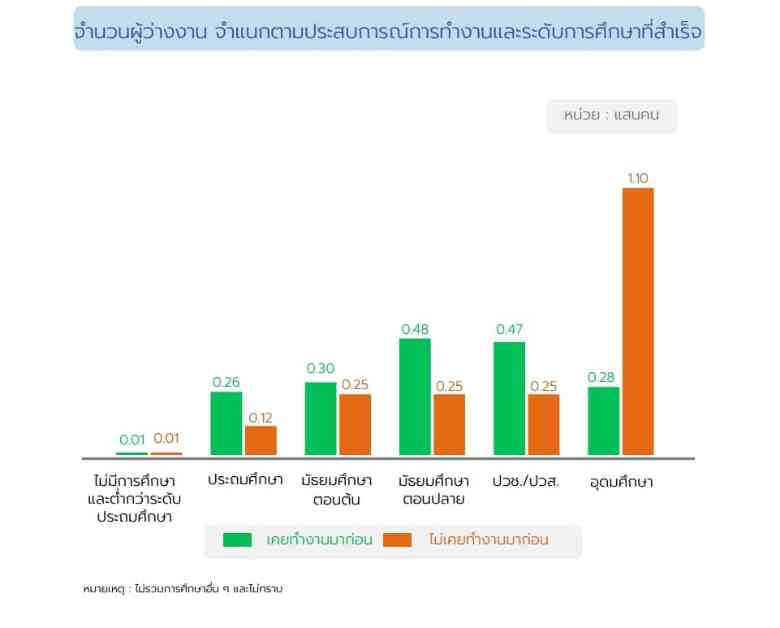June Unemployment Rate Analysis: 1.39 Million Graduates Out of Work
The National Statistical Office under the Ministry of Digital Economy and Society recently released the findings of their survey on the employment status of the population in June 2024. The survey revealed that out of the 59.19 million people aged 15 and above, 40.88 million were part of the labor force or ready to work. This group comprised 40.40 million individuals employed, 0.38 million unemployed, and 0.10 million waiting for the season to change. On the other hand, there were 18.31 million people outside the labor force, including homemakers, students, children/elderly, and individuals with illnesses or disabilities.
Comparing the data to May 2024, there was an increase of 1.26 million employed individuals, rising from 39.14 million to 40.40 million. In June 2024, the agricultural sector saw an increase in employed individuals, totaling 12.59 million (up from 1.89 million in May 2024), while non-agricultural employment decreased to 27.81 million (down from 0.63 million in May 2024). The top three sectors that experienced a decrease in employment were manufacturing (down by 450,000 individuals), wholesale and retail trade, repair of motor vehicles (down by 240,000 individuals), and other service activities (down by 170,000 individuals). On the contrary, the top three sectors that saw an increase in employment were transportation and storage facilities (up by 340,000 individuals), accommodation and food service activities (up by 150,000 individuals), and real estate activities (up by 90,000 individuals).
Analysis of Working Hours in June 2024
When analyzing the number of hours worked per week in June 2024, it was found that 26.68 million people worked 35-49 hours per week, accounting for 66.0% of the total employed population. Additionally, 7.34 million individuals worked 50 hours or more per week, making up 18.2% of the workforce. Those working less than 35 hours per week totaled 6.38 million individuals, representing 15.8% of the workforce.
In terms of time-related underemployment, which refers to individuals working 1-34 hours per week and desiring more work, it was found that 1.39 million individuals fell into this category, accounting for 0.3% of the total employed population. When broken down by gender, there were more males (0.90 million individuals) than females (0.49 million individuals) in this group.
Unemployment Trends in June 2024
In June 2024, the number of unemployed individuals stood at 3.79 million, equating to an unemployment rate of 0.9%. Comparing this data to May 2024, there was a decrease of 1.03 million unemployed individuals (down from 4.82 million to 3.79 million). Almost every region experienced a decrease in unemployment, except for Bangkok, which saw an increase. The Northern and Northeastern regions had similar unemployment rates.
When looking at unemployment by gender in June 2024, both males and females saw a decrease in unemployment rates compared to May 2024 (1.2% to 0.9% for males and 1.2% to 1.0% for females, respectively). Analyzing unemployment rates by age group revealed a decrease in unemployment rates for both adolescents (aged 15-24) and adults (aged 25 and above) from May 2024 (7.0% to 5.1% for adolescents and 0.6% to 0.5% for adults, respectively).
Educational Attainment and Work Experience of the Unemployed
In June 2024, it was observed that the highest number of unemployed individuals had completed tertiary education, totaling 1.39 million individuals. This was followed by individuals with upper secondary education (0.72 million individuals) and lower secondary education (0.55 million individuals). Comparing this data to May 2024, almost every educational level saw a decrease in the number of unemployed individuals, except for upper secondary education, which saw an increase.
When considering work experience, it was found that 1.80 million unemployed individuals had previous work experience, with more individuals transitioning from non-agricultural to agricultural sectors (1.73 million and 0.07 million individuals, respectively). On the other hand, 1.99 million unemployed individuals had no prior work experience.
Among unemployed individuals with prior work experience, those with upper secondary education had the highest numbers, with 0.48 million individuals (26.7% of the group) having completed this level of education. This was followed by upper secondary vocational education (0.47 million individuals, 26.1%) and lower secondary education (0.30 million individuals, 16.7%).
Unemployed individuals without prior work experience had the highest numbers among those who completed tertiary education, with 1.10 million individuals (55.3% of the group). This was followed by lower secondary education, upper secondary vocational education, and primary education, with 0.25 million, 0.12 million, and 0.12 million individuals, respectively.
In conclusion, the unemployment rate in June 2024 saw a decrease compared to the previous month, with various sectors experiencing shifts in employment trends. The data also highlighted the educational attainment and work experience of the unemployed population, shedding light on potential areas for intervention and support in the labor market.




















